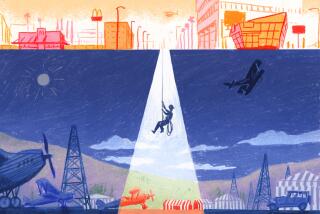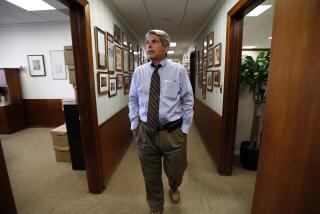An Opportunity to Gaze Down the Paper Trail of American History
- Share via
There were gasps -- and some guffaws -- as Los Angeles residents got a close-up peek Thursday at historical documents that mark some of this country’s most important moments.
Some choked back emotion as they read a poignant speech written for President Nixon to read in 1969 in case astronauts Buzz Aldrin and Neil Armstrong were marooned on the moon and could not be rescued. “Fate has ordained that the men who went to the moon to explore in peace will stay on the moon to rest in peace,” began the speech that never had to be delivered.
For the record:
12:00 a.m. Oct. 11, 2003 For The Record
Los Angeles Times Saturday October 11, 2003 Home Edition Main News Part A Page 2 National Desk 1 inches; 33 words Type of Material: Correction
Arnold exhibit -- An article in Friday’s California section on an exhibit at the Los Angeles Public Library incorrectly said that Benedict Arnold’s act of treason was in 1789. It was in 1779.
Others laughed out loud as they looked over actor John Wayne’s 1942 application to join the spy agency now known as the CIA. In it, he included among his qualifications having done “falls and posse riding in pictures” --which he stressed was “not as easy as it sounds.”
Most looked solemn as they studied Nazi Germany’s signed surrender document from 1945, Thomas Edison’s original 1879 patent application for the light bulb, the actual 1803 Louisiana Purchase Treaty and the handwritten official voting record of the 1787 Constitutional Convention.
The documents are part of a free exhibit at the Los Angeles Central Library of 25 historic papers. The traveling show, “American Originals: Treasures From the National Archives,” is making its only West Coast stop at the downtown library through Jan. 4.
Private donations are financing the $900,000 exhibition, said city Librarian Susan Kent. Besides covering the $150,000 exhibition fee, the contributions are paying for education consultants to coordinate schoolchildren’s visits and for an interactive history exhibit linked to the documents, she said.
“We felt if we had a once-in-a-lifetime opportunity to bring these to L.A., we would go all out,” Kent said.
The exhibition’s highlight will come Dec. 5, when the original Emancipation Proclamation signed in 1863 by President Lincoln will be displayed for four days.
Considered one of the greatest documents of human freedom ever written, it is said to be too fragile to be shown during the whole three-month exhibition.
But a preliminary draft of the proclamation is included in the current display. Handwritten by Lincoln in 1862 to signal his intention to free slaves in the South, it drew crowds of schoolchildren Thursday.
“It’s really impressive to see the actual writing. This is not a replica, this is it,” marveled 16-year-old Chanelle Johnson of Van Nuys. “You don’t expect to come and see the actual thing.”
Johnson, an African American, turned from the glass case holding Lincoln’s declaration and walked a few steps to a spotlighted cabinet displaying the 1964 Civil Rights Act. Bearing the smeared-ink signature of President Johnson, it is the law that sought to end racial discrimination in this country.
“Without something like this, I wouldn’t be here right now with all these other people here seeing this,” she said, looking toward the diverse crowd studying the exhibits. “The people in this room are a reflection of what these documents have done.”
Other displays include President Kennedy’s handwritten 1961 inaugural address scrawled on a yellow legal pad, a letter from Benedict Arnold to George Washington after Arnold’s 1789 betrayal of the American cause, and an 1898 appeal written by Hawaiian Queen Liliuokalani to the U.S. protesting the annexation of Hawaii.
John Wayne’s spy application was not accepted by the former Office of Strategic Services, despite the actor’s self-typed resume that boasted of his deep-sea fishing and hunting skill.
One of the reasons may have been that Wayne, then known by his real name, Marion Morrison, typed his list of “sports and hobbies” in the wrong space on the application form and had to cross it out.
“He had athletic ability, but I think they may have been looking for someone more intellectual,” said a grinning Susanne Pennoyer, a tutoring project manager who lives in Venice.
“No, I don’t think he’d have made a good spy.”
More to Read
Sign up for Essential California
The most important California stories and recommendations in your inbox every morning.
You may occasionally receive promotional content from the Los Angeles Times.














